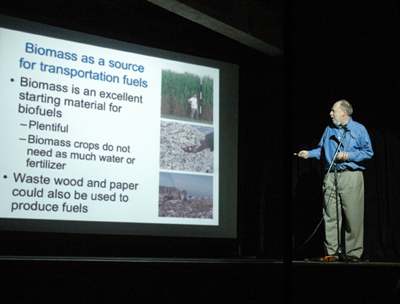 |
Poetry, Film, Readings, and Graham Fleming: a Wild ‘Grotto Night’
By David Gilbert
|
|
|
|
 |
 |
|
|
Fleming |
|
|
|
"What does a Ferrari screaming through the cobbled streets of Paris at 140 miles per hour, NASCAR poetry, a monologue in Pidgin English about Nigerian oil and politics, parking in New York’s Chinatown, a pop-rap rendition of Dr. Seuss’ Go, Dog. Go! and Berkeley Lab’s bioenergy vision have in common?
They all have to do with the world’s “Driving Obsession,” the theme of a recent edition of “Grotto Nights” in San Francisco. Berkeley Lab Deputy Director Graham Fleming, whose presentation was bracketed by the other acts, sobered up the crowd with “the Al Gore section of the show” which, he said, relieved him of the necessity of telling any jokes. He went on to present to the crowd of several hundred, gathered in the dark lofty “Mezzanine” performance space behind the old Mint in San Francisco, the hard data that describe the situation at the collision point of climate, energy use, and future demand.
“Grotto Nights” is a periodic happening sponsored by the Grotto, a collective workspace community for writers, filmmakers and narrative artists. The eclectic, themed evenings of literature, film, art and science combine performance and conversation among the city’s literati. This one, on Feb. 5, was billed as “a night of reportage, science and art in the form of a subversive Valentine to our cars.”
Enter physical chemist Fleming, who was invited into this most unusual mix. And they embraced him. Challenged with the prospect of the world’s energy use doubling in the next 50 years, he asked the attentive crowd, “Could we just go on doing what we’re doing, if we didn’t care about the political consequences, military consequences, and the costs? The answer is no.
“Let’s say we wanted to make all the new energy that we’ll need in the next 50 years from nuclear power (a position, he cautioned, that he was not advocating). How many nuclear power plants would we need? Well, we’d have to
make one every two days. This isn’t even conceivable if we thought it was a good idea.”
Ramping off the dire predictions from the recent Intergovernmental Panel on Climate Change—implicating the industrialized world role in generating the greenhouse gases that contribute to global warming—Fleming asked the crowd, “What should we do?”
“Everything we can think of,” he responded. “We should figure out how to store the CO2 from power stations, oil wells, and gas wells. We should think about cleaner fossil fuel power plants, windmills, we certainly can’t rule out as a temporary measure fission power.”
There is hope, he suggested, pointing to Berkeley Lab’s Helios Project, dedicated to exploring the ways that sunlight can be converted into liquid fuels for transportation.
In 2000, the U.S. used 3.3 terawatts of power. The solar energy falling on the U.S. is 1,500 terawatts. If we can tap only a few percent, he said, we could become self-sufficient.
“We can do it through plants and by engineering microbes,” Fleming told them. “If we could convert sunlight to fuels at 1 percent efficiency, which we can’t do right now, we could replace all the gasoline that the U.S uses.”
In his segue to the Energy Biosciences Institute—the successful bid for the $500 million BP grant to UC, Berkeley Lab, and the University of Illinois—the mere mention elicited raucous applause from the enthusiastic crowd.
After Dr. Fleming’s densely-packed 15 minutes came to a close, Dr. Seuss had his tribute, the lights went up, and some of the black-clad literati sampled the assorted biofuels on offer at the bar, and the discussion heated up.
|
 |

